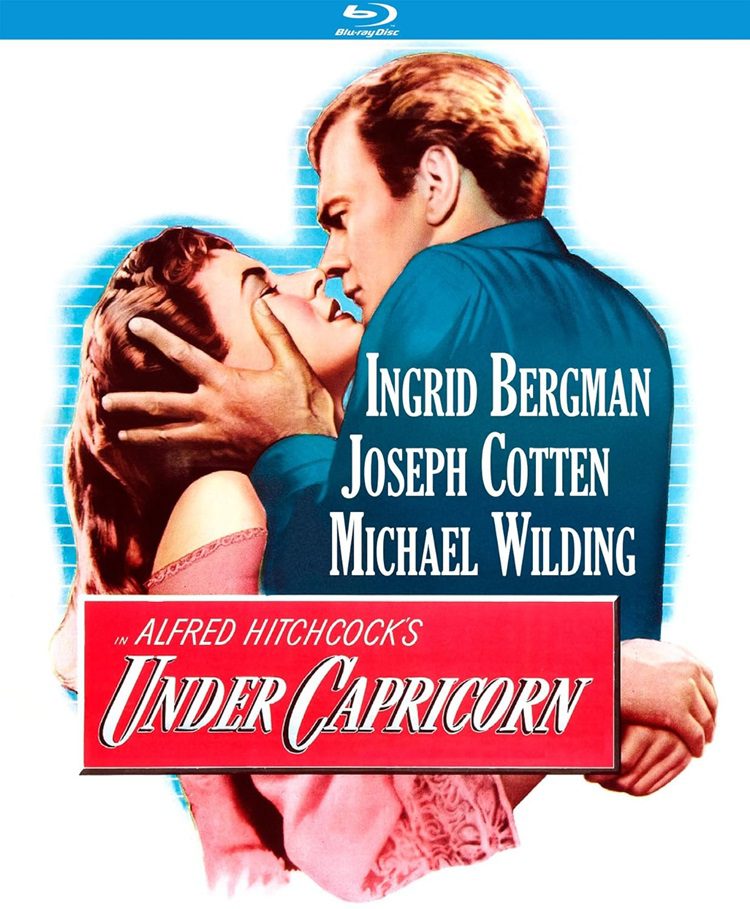
In his interviews with Francois Truffaut (which is included in this set via audio format), Alfred Hitchcock admits that Under Capricorn was a bit of a failure. He believed this was due to his over-excitement over Ingrid Bergman (then one of the world’s biggest stars) agreeing to be in the picture. He paid so much attention to her and the media fawning over her that he didn’t give the script the good working over it needed.
Based upon a book by Helen Simpson, it was adapted by Hitchcock’s friend Hume Cronyn (an actor with little writing experience) and written by James Bridle (a playwright with no film experience and whom Hitchcock says could never land an ending). It was a critical and financial bomb. So much so that the bank that financed the film bought back the rights causing it not to be shown publicly for many years until television stations began buying the rights to show it. The first time I watched the film I quite disliked it. I’d actually forgotten I had previously watched it until I noticed I had given it a dismal 3-star rating on IMDB. I liked it quite a bit better this time round but it is still a very flawed film.
It is set in Sydney, Australia in 1831 when the city is still a rough frontier town filled with ex-convicts sent to Australia by the British government to do hard labor. It stars Joseph Cotten as Sam Flusky, who did seven years as a prisoner for killing a man but who has now become a very successful businessman. He is married to Bergman’s Henrietta, an aristocrat who besmirched her name when she married the lower-class Sam. She traveled to Australia with him and waited for his prison term to be over. The wait and the hard life brought her low and she now spends most of her days and nights drinking herself into a stupor.
A new governor arrives in town and brings with him his second cousin Charles (Michael Wilding), a charming but indolent man who is a bit of a dandy. Charles befriends Sam and as it turns out is a childhood friend of Henrietta. Earning the ire of the governor over associating with such low people, Charles moves in with the Flusky’s and attempts to rehabilitate Henrietta back into the social class. It is a difficult task, faced with many obstacles including the governor, the housekeeper Milly (Margaret Leighton who outshines them all), as well as the rest of the staff who follow Milly’s orders and perpetually disrespect Henrietta.
Under Capricorn is definitely second or third tier Hitchcock. The acting is good and there are some nice directorial flourishes, but the script is weak. It is essentially a romantic triangle but there is so little heat between the three leads that I hardly cared a wink over who wound up with the girl. There is very little suspense, and what there is (including a moment in the final act in which one of the characters might get hanged) is so limply executed one can hardly be bothered to notice. Hitchcock may have been overly excited to have Ingrid Bergman in his picture but he somehow made one of the most beautiful woman in the world look dour and unpleasant.
Much like his most previous film, Rope, Hitchcock was fascinated with long takes during the making of this film. Several times he used up an entire reel of film (lasting approximately 10 minutes) for one take. He uses it to great effect allowing us to visually sense the characters class, as well as their feelings of guilt or shame. There are two scenes which begin with an intimate moment being shared between Charles and Henrietta and end with a long pan across the room and into another where we see Sam sulking in a jealous rage. Another scene follows Sam as he sneaks around the mansion, climbs up a the wall, and into Henrietta’s room. The camera, with use of a good crane, climbs right along behind him before moving in close turning an objective shot into a POV without a cut.
Kino Lorber had given Under Capricorn a new 4K restoration and its a definite upgrade from previous home-video releases. This was the second film in which Hitchcock used Technicolor process and he uses it brilliantly. Contrasting shades delineate the character’s inner feelings and Charles’ bright, florid clothes clash brilliantly up against Sam’s more drab garments. All of which are presented beautifully in this transfer. I did notice quite a bit of debris and scratches throughout. The audio is good with the dialogue (and it is a very talky movie) coming in crisp and clear.
Extras include a very informative commentary track from film historian Kat Elliger, the aforementioned conversation between Truffaut and Hitchcock, and an archival interview with Claude Chabrol who discusses the French New Wave’s relationship with Hitchcock (apparently the French love this movie considering it one of the director’s best).
Under Capricorn is certainly not Hitchcock’s best, but it’s got some good moments including a truly brilliant performance from Margaret Leighton and some really interesting long takes. Kino Lorber has done a decent job of restoring it and the extras make it a good purchase for fans.